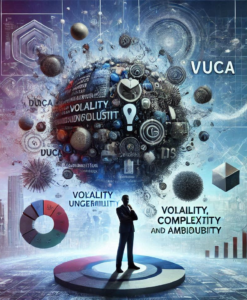
Business Relationship Management is a strategic approach to aligning an organization’s business objectives with its IT services and portfolio. In a VUCA (Volatility, Uncertainty, Complexity, Ambiguity) environment, where change is constant and the business landscape is unpredictable, planning for a BRM role is very challenging and BRM has to work on below key considerations to ensure him/her able to add value in these uncertain times. The relationship strategy requires a dynamic and adaptive approach.
Here’s a brief breakdown of each component:
Volatility: The nature and dynamics of change, and the speed at which it happens.
Uncertainty: The lack of predictability and the difficulty in understanding what is happening and what the outcomes might be.
Complexity: The multiple, interconnected factors that make decision-making challenging.
Ambiguity: The lack of clarity about the meaning of an event or situation, often due to incomplete or contradictory information.
Here are key considerations for IT BRM in a VUCA context:
- Understand the Business Environment:
- Continuous Environmental Scanning: Regularly review the business environment for changes, trends, and potential disruptions with business leaders in regular interactions and monthly meetings. Stay informed about industry shifts, regulatory changes, and emerging technologies that could impact the business and see where business needs more engagement and understanding. BRM can identify the gaps by doing SWOT, PESTLE analysis, Porter’s Five Forces analysis so that risk and gaps can be accessed to support this business environments.
- Scenario Planning: Develop scenarios that consider various possible futures. This helps in understanding potential business needs and challenges, allowing IT BRM to proactively respond to different situations while planning for stakeholder engagement.
- Value Co-Creation:
- Co-Creation Workshops: Conduct co-creation workshops with business stakeholders to identify areas of collaboration and innovation. This will bring more visibility on IT initiatives, quick wins and how it can aligned to business strategy. Explore opportunities for jointly creating value and achieving shared objectives. This is also part of RSOAP (Relationship strategy on a Page) when BRM started developing the same and working on shared vision.
- Outcome-Focused Discussions: Shift discussions from IT-centric topics to business outcomes. Focus on how IT initiatives contribute to achieving specific business results, challenges, risk mitigation and ways to present to management so that they can understand that technology or digital can addresses these environment and business can get more from the BRM engagement.
- Business Capability Mapping:
- Dynamic Capability Mapping: Regularly update and reassess business capability maps. Understand how changes in the business environment affect existing IT capabilities, Portfolio, Services and identify new capabilities that may be needed to support this challenging environment. This will also help to evaluate partner’s capabilities and help organisation to review their IT service portfolio with changing market conditions.
- Strategic Alignment: Ensure that IT initiatives are aligned and contribute to the development of critical business capabilities. As BRM prioritize efforts that can enhance the organization’s strategic strengths. In VUCA state the business capabilities keep on changing for e.g. in M&A different cultural teams and higher leadership gets impacted with transition and a big cultural shift happens so BRM has to see that relationship building should be core priority for strategic alignment.
- Continuous Improvement:
- Feedback Loops: Establish feedback loops with business stakeholders. Regularly seek input on the effectiveness of IT services, partner feedback, IT service portfolio review, value clarity and the alignment of initiatives with business goals, and opportunities for improvement. Also take external feedback of customer of your services are client facing suing surveys, NPS etc.
- Retrospectives: Review past initiatives and relationships. Identify lessons learned and apply continuous improvement principles to enhance BRM practices and engagement.
- Technology Trends and Innovation:
- Innovation Forums: Attend seminar, panel discussion and engage technology sessions with business and digital leaders so that they feel engaged and aware of emerging technologies and innovation opportunities. Collaborate with business stakeholders to identify how new technologies can address business challenges and create value.
- Technology Roadmaps: Develop technology roadmaps that align with the business strategy. Ensure that IT investments support the organization’s long-term goals and can adapt to changes in the technology landscape.
By integrating these considerations into the BRM strategy, IT leaders in this role can navigate the uncertainties of a VUCA environment, foster strong collaborations with business stakeholders, and ensure that IT services contribute strategically to the organization’s success. The key is to remain agile, adaptable, and closely aligned with the evolving needs and priorities of the business.
For more details on BRM please refer to https://brm.institute/



